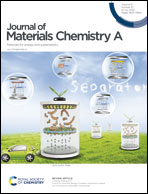Assembled caseins as crosslinkers for tough, adhesive and self-healing hydrogels towards flexible sensors†
Abstract
Hydrogels have garnered considerable research attention due to their softness and stimuli-responsiveness in a variety of fields including flexible and wearable sensors. Despite significant advances in mechanical enhancement by employing nanostructures as cross-linkers to regulate network structures, their limited functionality, particularly adhesion and biocompatibility, has greatly hindered their practical application. Here, we report smart hydrogels fabricated by in situ polymerization using assembled casein nanostructures as crosslinking agents. Due to the enhanced branching on the crosslinking points, the fabricated hydrogel with a uniform network structure demonstrated excellent mechanical performance with a stretchability as high as 1600%, a crack strength at 3.7 MPa, and notch insensitivity. In comparison to traditional samples, the crosslinked network demonstrated significantly improved adhesion strength by combining the adhesive behavior of casein units. Furthermore, the presence of reversible metal coordination motivated the hydrogel with multi-responsive self-healing performance under microwave irradiation and alkaline conditions. These excellent performances could be well maintained at wide temperatures ranging from −20 °C to 60 °C with the assistance of glycol. Because of the massive ions throughout the polymer network, flexible and wearable sensors with high performance under diverse mechanical deformations can be facilely fabricated.



 Please wait while we load your content...
Please wait while we load your content...